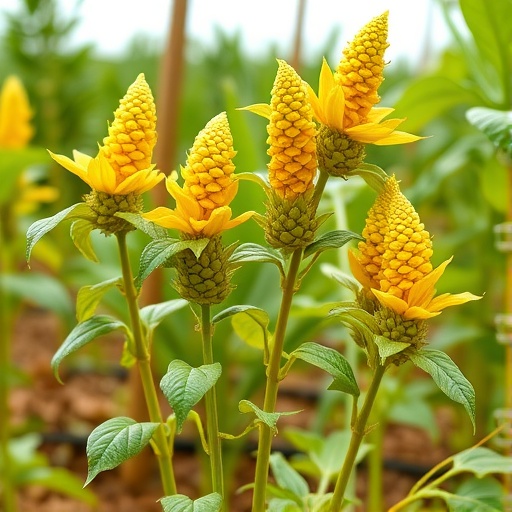In the world of botanical research, turmeric, scientifically known as Curcuma longa, has emerged as a pivotal focus due to its historical significance and wide-ranging applications. Recently, a groundbreaking study sheds light on the effects of various genotypes and contrasting production environments on the stability of curcuminoids in turmeric. This research provides critical insights that could shape future agricultural practices and enhance the quality of turmeric as a health supplement.
Curcuminoids are the active compounds found in turmeric, responsible for its vibrant yellow color and numerous health benefits. Their stability and efficacy, however, are significantly influenced by both genetic diversity and environmental conditions. In the collaborative study conducted by Silaru, Sounderarajan, Kotha Madduri, and their team, the researchers meticulously examined how different genotypes of turmeric responded to varying environmental conditions, all of which play crucial roles in curcuminoid synthesis and stability.
One of the focal points of the study was the way different genetic varieties of turmeric adapt to their surroundings. This adaptability is integral not just for crop yield but also for the concentration and stability of curcuminoids. Environmental factors such as soil quality, moisture levels, sunlight, and temperature greatly affect turmeric’s growth and bioactive compound production. The study meticulously documented these interactions, presenting a wealth of data that illuminates the complex relationship between genetic makeup and environmental stressors.
Furthermore, the research delved into the mechanisms behind curcuminoid stability. Turmeric’s curcuminoids are known to be sensitive to heat, light, and pH changes, which can impact their therapeutic efficacy. By subjecting different genotypes to diverse environmental stressors, the researchers aimed to determine how effectively the turmeric plants could maintain their curcuminoid levels. The findings showed that certain genotypes exhibited a remarkable ability to stabilize these compounds, suggesting potential pathways for selective breeding in turmeric cultivation.
The authors emphasized the importance of understanding these dynamics for both farmers and consumers. For farmers, cultivating the right genotype in optimal environmental conditions could lead to better yields and higher-quality turmeric, which is essential given the increasing global demand for natural health products. Consumers, on the other hand, can benefit from knowing which turmeric varieties are most potent and stable, which is crucial for those using turmeric for its health benefits.
Interestingly, the study also highlighted the role of genetic variation in the biochemical pathways that produce curcuminoids. Certain genotypes appear to have enhanced metabolic pathways that favor higher curcuminoid synthesis. This insight could lead to genetic engineering approaches or conventional breeding strategies aimed at boosting curcuminoid content in turmeric crops.
Moreover, the researchers noted the potential impact of climate change on turmeric production. As environmental conditions shift, the abilities of various turmeric genotypes to adapt are becoming increasingly important. The study’s findings could inform breeding programs that aim not only for higher curcuminoid content but also for resilience against climate-induced stressors.
In addition to its implications for agriculture, the study also opens avenues for further research into the health benefits of turmeric. Curcumin, the primary curcuminoid in turmeric, is widely recognized for its anti-inflammatory and antioxidant properties. Understanding how different genotypes affect curcumin levels can enhance the development of turmeric-based supplements that maintain their efficacy throughout storage and use.
The comprehensive nature of this research also paves the way for future comparative studies between various species within the Curcuma genus. By expanding the genetic landscape studied, scientists could uncover additional sources of curcuminoids with enhanced properties, both for health benefits and for culinary use.
In conclusion, the insights provided by this pioneering research offer a promising perspective on the future of turmeric cultivation and utilization. The interplay between genotype and environment is a complex yet fascinating domain that holds significant implications for agriculture, health, and nutrition. As the research community continues to unravel these complexities, the potential for turmeric as a superfood becomes even grander, promising not just enhanced health benefits but also sustainable agricultural practices that can adapt in a changing world.
As the study is published in Biochemical Genetics, it is anticipated that these findings will spark further interest and investigation. The significance of selective breeding and the cultivation of resilient, high-yield turmeric varieties cannot be overstated, especially as global demands for natural health solutions continue to rise. This research sets a foundational stone for policies aimed at improving agricultural practices and dietary health through the cultivation of turmeric with optimized curcuminoid profiles.
With curcumin’s established reputation in the field of functional foods, this study offers a lucid argument for advancing turmeric cultivation through informed genetic choices. As the findings circulate among farmers, researchers, and dietary supplement producers, a collective effort could be initiated toward enhancing the future of turmeric, aligning agricultural practices with health advancements to yield incredibly valuable results for diverse populations globally.
Ultimately, understanding and harnessing the genetic potential of turmeric, guided by robust research, will not only benefit farmers seeking better crops but also consumers in search of potent health benefits. The ripple effects of such research could lead to a healthier population, leveraging the historical and present-day significance of this remarkable plant.
Subject of Research: The influence of genotypes and contrasting production environments on curcuminoids and their stability in turmeric.
Article Title: Influence of Genotypes and Contrasting Production Environments on Curcuminoids and its Stability in Turmeric (Curcuma longa L.)
Article References:
Silaru, R., Sounderarajan, A., Kotha Madduri, Y. et al. Influence of Genotypes and Contrasting Production Environments on Curcuminoids and its Stability in Turmeric (*Curcuma longa* L.).
Biochem Genet (2025). https://doi.org/10.1007/s10528-025-11239-4
Image Credits: AI Generated
DOI:
Keywords: Turmeric, Curcuminoids, Genotypes, Production Environments, Stability, Agriculture, Health Benefits.




